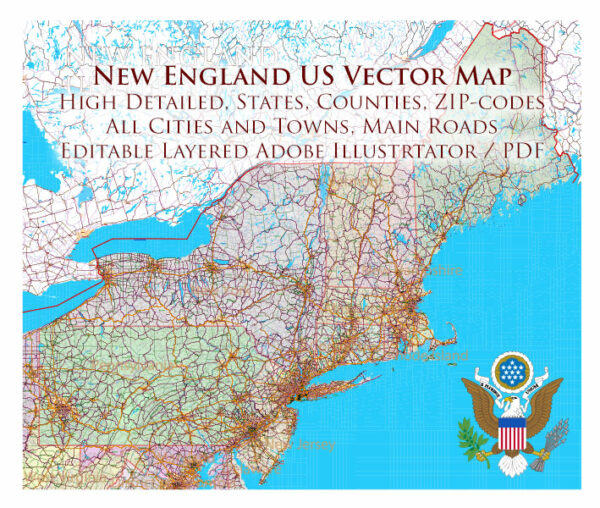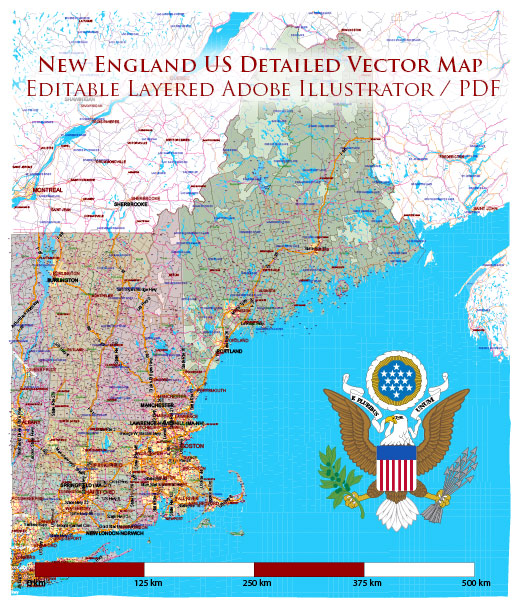New England is a region in the northeastern corner of the United States, known for its rich history, diverse culture, and stunning natural landscapes. The region comprises six states: Connecticut, Maine, Massachusetts, New Hampshire, Rhode Island, and Vermont.
Vectormap.Net provide you with the most accurate and up-to-date vector maps in Adobe Illustrator, PDF and other formats, designed for editing and printing. Please read the vector map descriptions carefully.
Here’s a detailed description of the geography and nature of New England:
- Topography:
- Mountains: The region is characterized by the Appalachian Mountains, which run through parts of Vermont, New Hampshire, and western Maine. The White Mountains in New Hampshire are particularly notable for their rugged beauty and outdoor recreation opportunities.
- Coastline: New England has a picturesque coastline along the Atlantic Ocean, featuring rocky shores, sandy beaches, and charming coastal towns. The region’s maritime history is reflected in its lighthouses and fishing communities.
- Climate:
- Varied Climate: New England experiences a mix of climates, with a humid continental climate prevailing inland and a humid subtropical climate along the coast. Winters can be cold with snowfall, especially in northern areas, while summers are generally warm and humid.
- Forests:
- Lush Forests: Large portions of New England are covered by dense forests, including hardwoods like maple, oak, and birch. The forests provide habitat for diverse wildlife, including deer, moose, black bears, and various bird species.
- Rivers and Lakes:
- Scenic Rivers: Several rivers traverse the region, including the Connecticut River, which forms the boundary between Vermont and New Hampshire. These rivers contribute to the region’s scenic beauty and provide recreational opportunities such as kayaking and fishing.
- Quaint Lakes: New England is dotted with lakes, both large and small. Lake Champlain, shared by Vermont and New York, is one of the largest, while smaller lakes are scattered throughout the region, offering serene settings for outdoor activities.
- Historical Landmarks:
- Colonial Architecture: New England is renowned for its well-preserved colonial architecture, especially in cities like Boston and Providence. Historic sites such as Plymouth Rock and the Freedom Trail in Boston offer glimpses into the region’s early history.
- Islands:
- Coastal Islands: There are numerous islands off the coast of New England, some of which are popular tourist destinations. Notable examples include Martha’s Vineyard and Nantucket in Massachusetts.
- National Parks and Reserves:
- Acadia National Park: Located in Maine, Acadia National Park is known for its granite peaks, woodlands, and coastal scenery. It offers a range of outdoor activities, including hiking and wildlife viewing.
- Cultural Heritage:
- Diverse Culture: New England has a rich cultural heritage influenced by its early colonial history. The region is known for its literature, education institutions, and vibrant arts scene.
Overall, New England’s geography and nature offer a diverse range of landscapes, from coastal beauty to mountainous terrain, making it a destination for both outdoor enthusiasts and those interested in history and culture.



 Author: Kirill Shrayber, Ph.D.
Author: Kirill Shrayber, Ph.D.